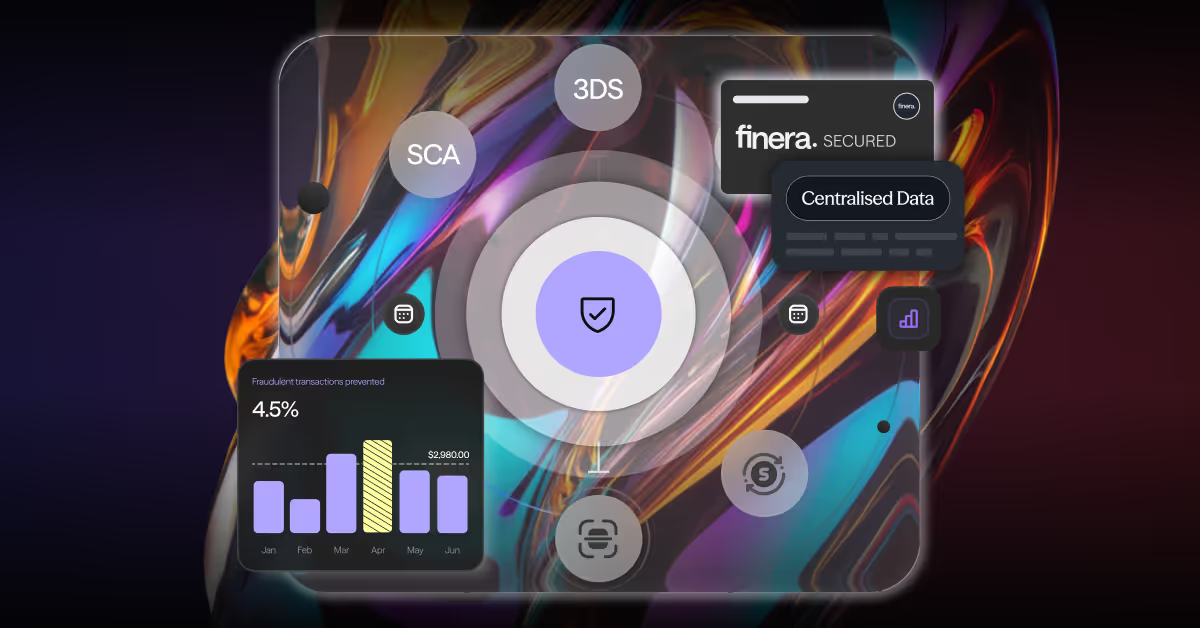SaaS Fraud Prevention: How Smart Payments Orchestration Protects Revenue
Smart payment orchestration helps SaaS platforms fight fraud, cut chargebacks, and protect revenue.

In the SaaS economy, recurring payments are the lifeblood of the business. But where there’s steady transaction volume, there’s also opportunity for fraud. Whether it’s stolen card details, fake sign-ups or chargeback abuse, SaaS fraud silently drains revenue, damages trust and inflates operational costs.
As digital transactions grow, so does the sophistication of bad actors. In Stripe’s 2024 Annual Letter, the company notes that online fraud continues to rise as fraudsters become more sophisticated, emphasizing the need for smarter prevention tools. Traditional fraud filters aren’t enough anymore, they block genuine customers almost as often as fraudsters.
This is where payment orchestration reshapes the picture. By unifying fraud detection, smart routing and acquirer optimisation, finera. helps SaaS platforms detect, prevent and respond to fraud, all without sacrificing user experience.
The Growing Challenge of Fraud in SaaS
Unlike one-time retail purchases, SaaS platforms face continuous exposure. A single compromised account can lead to months of losses before detection.
Common SaaS fraud scenarios include:
- Stolen credit cards were used for fake subscriptions.
- Trial abuse, where users repeatedly sign up with different identities.
- Chargeback fraud, when customers falsely dispute legitimate payments.
- Account takeover (ATO) via credential stuffing or phishing.
- Refund abuse, where fraudsters manipulate refund processes for profit.
What makes SaaS fraud harder to fight is its subtlety. It hides behind real customers and recurring billing cycles. A failed payment might not be fraud and a chargeback might be a legitimate complaint. The key is real-time context and orchestration intelligence.

Why Traditional Fraud Tools Fall Short
Standalone fraud systems are designed to stop suspicious activity, not to understand it in a payments context.
Typical limitations include:
- Fragmented data between payment gateways, acquirers and fraud vendors.
- High false positives, where valid transactions are wrongly blocked.
- Rigid rule-based systems that can’t adapt to new fraud patterns.
- Lack of visibility across global payment flows.
For SaaS companies operating across multiple regions, currencies and acquirers, this fragmentation can hurt both security and conversion rates. Declining a legitimate transaction can be just as damaging as approving a fraudulent one.
How Payment Orchestration Enhances Fraud Prevention
Payment orchestration platforms like finera. bridge the gap between security and performance. Instead of treating fraud as a separate layer, orchestration integrates it into every step of the payment flow.
1. Centralised Data and Real-Time Insights
finera. aggregates transaction data across all payment providers, gateways and acquirers. This provides a unified fraud view by helping businesses detect patterns such as unusual geographies, repeated card use or sudden subscription spikes.
2. Smart Routing to Trusted Acquirers
Fraud risk varies across regions and acquirers. finera.’s smart routing engine can automatically direct transactions through acquirers with the best fraud-detection performance for a given geography or payment method, improving both security and authorisation rates.
3. Adaptive Risk Scoring
Instead of rigid “approve/deny” logic, orchestration platforms can apply dynamic risk scoring by combining behavioural data, device intelligence and transaction history. This reduces false declines and enables smarter authentication flows (e.g., 3D Secure 2.0 triggers only when risk is high).
4. Multi-Layered Protection
finera. supports multiple fraud-prevention layers:
- Pre-transaction screening for high-risk profiles.
- Post-transaction monitoring to flag chargeback patterns.
- Custom rules per market or customer segment.
This flexibility allows SaaS companies to balance fraud prevention with user experience, maintaining frictionless checkouts for trusted customers.
Reducing Chargebacks and Revenue Leakage
Fraud doesn’t just create losses, it damages relationships with payment networks. High chargeback ratios can lead to penalties, frozen funds or acquirer termination.
finera.’s orchestration helps mitigate this through:
- Proactive chargeback alerts allow SaaS businesses to respond before disputes escalate.
- Automated retries through secondary acquirers to recover failed payments.
- Transparent dispute data shared across systems, preventing repeated abuse.
The result is fewer disputes, lower fees and healthier merchant accounts.

Balancing Security and Conversion
SaaS companies can’t afford to make security an obstacle. Overaggressive fraud filters can block genuine customers and increase churn.
The orchestration model offers a better balance:
- Localise payment experiences - Different authentication flows per region.
- Apply selective authentication - 3DS or MFA only when necessary.
- Continuously learn from data - Adaptive systems improve over time.
finera.’s intelligence layer ensures fraud prevention never means lost sales. By optimising both fraud controls and authorisation rates, SaaS platforms can grow securely, not cautiously.
Future Trends in SaaS Fraud Prevention
The next generation of SaaS fraud prevention is being shaped by AI, real-time collaboration and compliance automation. Key trends include:
- Machine learning models trained on global transaction data to detect subtle anomalies.
- Behavioural biometrics, identifying users by their typing rhythm or device fingerprint.
- Cross-merchant intelligence, where fraud signals are shared across networks.
- Automated compliance, aligning with PSD3, PCI DSS 5.0, and evolving global standards.
finera.’s orchestration architecture is designed to integrate seamlessly with these innovations, ensuring that fraud prevention evolves with the payment ecosystem.
Building a Scalable Fraud Prevention Strategy
For SaaS leaders, the goal isn’t just to stop fraud but to build resilience. A scalable fraud strategy should:
- Unify data across all payment touchpoints.
- Leverage orchestration to adapt to the market.
- Integrate AI-driven risk scoring and authentication.
- Continuously measure performance across acquirers.
- Prioritise customer experience alongside security.
finera’s platform enables all five by combining control, flexibility and insight in one orchestration layer.
From Fraud to Advantage
Fraud prevention in SaaS isn’t a box to tick but a competitive advantage. Every blocked fraudulent payment protects revenue, strengthens trust and keeps merchant accounts healthy.
By integrating fraud intelligence directly into the payment flow, finera. turns payment orchestration into a proactive fraud-defence system, one that scales with your business and secures recurring revenue across borders.
Protect your SaaS revenue with smarter payments infrastructure - powered by finera.

This article on payment methods is for informational and educational purposes only.
- Not Professional Advice: The content provided does not constitute financial, legal, tax, or professional advice. Always consult with a qualified professional before making financial decisions.
- No Liability: The authors, contributors, and the publisher assume no liability for any loss, damage, or consequence whatsoever, whether direct or indirect, resulting from your reliance on or use of the information contained herein.
- Third-Party Risk: The discussion of specific payment services, platforms, or institutions is for illustration only. We do not endorse or guarantee the performance, security, or policies of any third-party service mentioned. Use all third-party services at your own risk.
- No Warranty: We make no warranty regarding the accuracy, completeness, or suitability of the information, which may become outdated over time.
Frequently Asked Questions
While Smart Payments Orchestration significantly reduces the risk of fraud, it cannot guarantee complete prevention of all fraudulent activities. It is essential to combine this technology with other security measures, such as user verification and transaction monitoring, to create a comprehensive fraud prevention strategy.
Continuous updates and improvements to the orchestration system are also necessary to adapt to evolving fraud tactics.
Businesses can implement Smart Payments Orchestration by partnering with payment service providers that offer this technology. It involves integrating the orchestration system into existing payment workflows and ensuring that all stakeholders are trained on its use.
Regularly reviewing and optimizing the orchestration settings based on transaction data will help maintain its effectiveness in preventing fraud.
Smart Payments Orchestration is a technology that optimizes payment processing by intelligently routing transactions through various payment gateways. This ensures that payments are processed efficiently and securely, reducing the risk of fraud.
By analyzing transaction data in real-time, smart orchestration can detect anomalies and prevent fraudulent activities before they occur.
Utilizing Smart Payments Orchestration offers several advantages, including enhanced security, improved transaction success rates, and reduced operational costs. By streamlining payment processes, businesses can focus on growth while minimizing the risk of fraud.
Additionally, it provides valuable insights into customer behavior, helping businesses make informed decisions.
SaaS Fraud Prevention refers to the strategies and technologies used to protect software as a service (SaaS) platforms from fraudulent activities. This includes identifying and mitigating risks associated with payment processing, user authentication, and data security.
Effective fraud prevention is crucial for maintaining trust and ensuring the integrity of transactions within SaaS applications.

Still Have Questions?
Let’s Find the Right Solution for You
Stay Connected with Us!
Follow us on social media to stay up to date with the latest news, updates, and exclusive insights!




